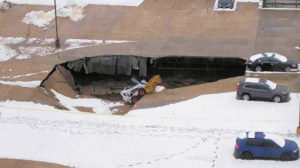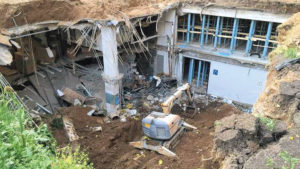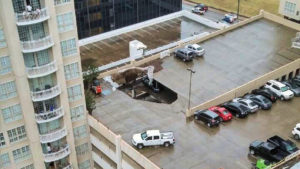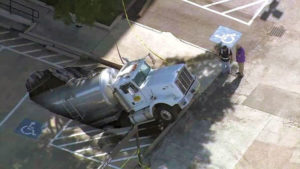Structural engineering always has been a conservative profession. This is particularly evident in the structural building codes and standards. These regulations are intended to protect the public from deficiencies in design and construction. For the most part, they are effective. Why then do so many parking garages collapse?
In 2015, at least six parking garages partially collapsed in the United States. More collapsed in 2016. Some failures might be due to deficient design or construction, or to inadequate maintenance, but most are due to excessive loading.
For decades, the codes and standards have stipulated that parking garages be designed for a minimum live load of 50 psf. This is more than adequate for sedans, SUVs, and half-ton pickup trucks. The average vehicle in the United States today weighs 4,009 pounds and can safely be parked in any code-compliant garage. With the margin of safety inherent in the codes and standards, failure becomes imminent only when actual live loads approach twice the minimum.
Some parking garages post maximum vehicle weights at their entrances. More commonly, the entrances limit vehicle height (thus, vehicle size/weight) with clearance bars typically set at 7 feet or less. Here are four examples where parking garages collapsed due to excessive loading.
Saturday, 01/24/15, Secaucus, NJ
A 3-level garage with 600 parking spaces serves the Harmon Plaza office tower, the Clarion Empire Meadowlands Hotel, and the Osprey Cove apartments. A Bobcat utility vehicle was plowing the top deck of the garage following a snowfall of 4 inches or less. The weight of the Bobcat was not a problem, nor was the weight of the accumulated snow. However, compacted snow weighs about 20 pcf, and 30 pcf or more if wet.
The snow had been pushed into a compacted pile. At 7:00 am, with the pile more than 4 feet high, the top deck of the garage collapsed under the combined weight of the snow pile and the Bobcat. The resulting opening swallowed the Bobcat and one vehicle parked below was crushed. No one was injured except the Bobcat driver, who had a mild concussion. On weekdays, the garage would have been filled with vehicles and people.
Friday, 05/01/15, Washington, D.C.
A 3-level garage serves the iconic Watergate mixed-use complex. Now more than 50 years old, the complex was undergoing a comprehensive restoration. A landscaping contractor placed soil and debris on the top deck of the parking garage. Soil weighs about 75 pcf if dry, and up to 125 pcf if wet. Thus, only one foot of soil might cause failure.
At 10:00 am, the top deck of the garage collapsed beneath the soil and debris. Everything on the two levels below was crushed in a pancake failure. Two people were injured, one critically, and about 35 vehicles were destroyed.
Friday, 10/23/15, Dallas, TX
A 7-level garage with 800 parking spaces serves the upscale Renaissance on Turtle Creek condominiums. The pool and amenities deck at the top of the garage were being renovated, and the contractor piled soil and miscellaneous debris at the toe of a ramp near one corner of the top deck of the garage. A video taken just a few hours before the collapse shows that the pile was about 3 feet high and was covered with plastic sheeting.
During a rainstorm, water flowed down the ramp and partially saturated the pile. At 5:00 pm, the top deck of the garage collapsed beneath the pile. Everything on the six levels below was crushed in a pancake failure. Amazingly, no one was injured. Numerous vehicles were destroyed, and about 250 vehicles and their contents remained inaccessible to their owners for 58 days. The garage remained closed for several months until reconstruction was completed.
Friday, 04/22/16, Houston, TX
An underground garage with an at-grade top deck serves adjacent office buildings on Town & Country Boulevard in Houston. The garage had been flooded during a period of record rainfall. A tanker truck was summoned to the site to pump out the water. The entrance to the top deck was blocked by a clearance bar proclaiming “MAXIMUM WEIGHT 4,000 LBS”, so the truck driver backed his tanker over the curb and onto the deck a few feet to the right of the entrance.
The tanker has a capacity of 5,800 gallons. That amounts to 48,400 pounds of water, not including the weight of the truck. As the tanker filled with water, the top deck eventually failed under the weight of the rear wheels. Fortunately, no one was injured.
Failure of Imagination
In the wake of the terrorism that jolted the United States on the morning of September 11, 2001, some smart person declared that the attacks succeeded in part because of a “failure of imagination” by multiple American security agencies. No one imagined that a zealous group of young men would simultaneously hijack four airliners full of fuel and fly them into predetermined targets using nothing more than box cutters, which were entirely legal to carry on flights at that time.
The parking garage collapses described in this article are not directly related to any known design, construction, or maintenance deficiencies. Nevertheless, with hindsight, all were preventable. In each instance, it could be argued that there was a failure of imagination. That is, a failure by parking garage designers and owners to imagine the utter lack of common sense among some of those working in and around the garages.
In Secaucus, the garage probably did not need to be plowed. The light snow likely would have melted within a day or two. If snow removal was necessary, it should have been done in a manner that avoided creating compacted piles.
In Washington and Dallas, the owners and the landscaping contractors should have contacted structural engineers for approval before the placement of any soil or debris, even temporarily, on the top decks of the garages. In Houston, an above-grade security fence or rail at the perimeter of the underground garage footprint would have kept heavy trucks off of the top deck.
Imagination is a difficult thing. The building codes and standards will never adequately address that which is unforeseen. This shifts the burden to structural engineers, and simply designing for large imaginary loads is clearly not the answer. Perhaps structural engineers should consider changing their approach to future parking garage projects.
In conclusion, the following describes two imaginative suggestions.
First, to reduce the likelihood of overload, structural engineers should seek “buy-in” from the owners of parking garages regarding loading limitations. Most manufactured products come with a manual that clearly defines intended use and a statement that the manufacturer is not liable when their product is used in other ways. Parking garage designers should consider a similar approach.
There is a precedent for this. In areas with expansive clay soils, prudent structural engineers require building owners to sign off on the acceptable differential movement of slabs on grade. A structural engineer could write a project-specific loading statement for a parking garage and require the owner to sign a brief document indicating that he or she has read, understands, and accepts the loading limitations for that garage.
Second, to limit the damage of a collapse, structural engineers should design parking garages to avoid progressive collapse or pancake failure. This is particularly important at the level immediately below the top deck. While not easily or inexpensively accomplished, this is doable and would substantially limit any damage caused by an overload at the top level.▪




